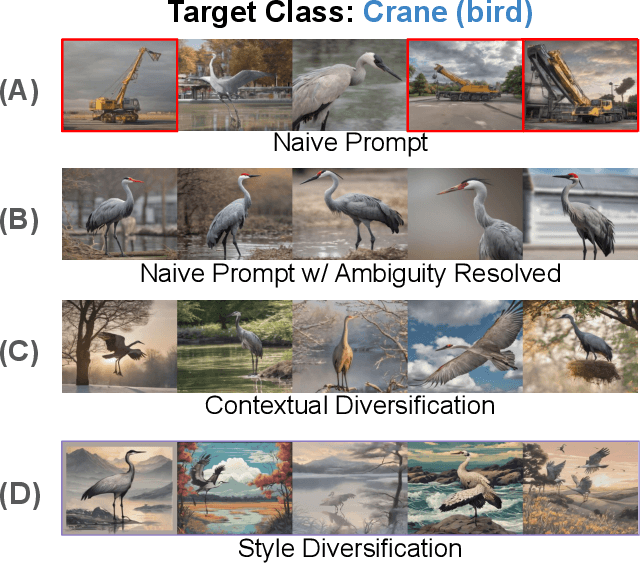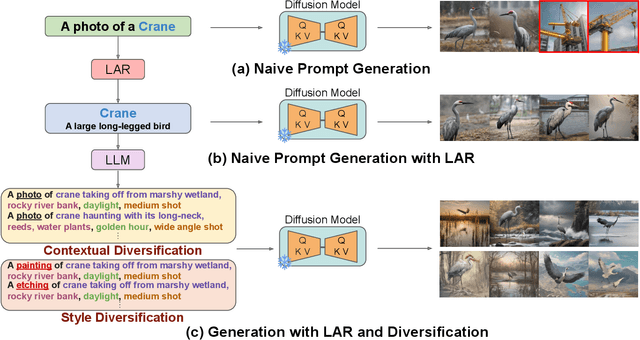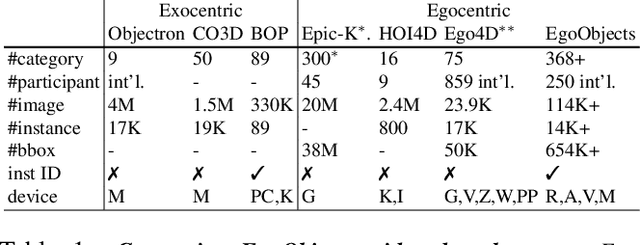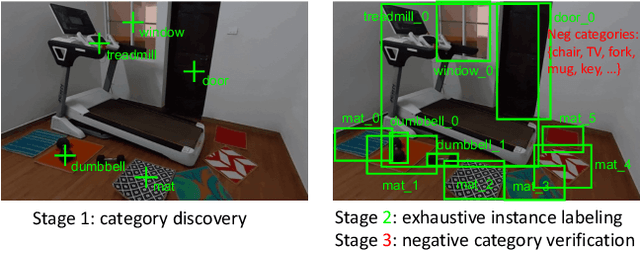Chenchen Zhu
EdgeTAM: On-Device Track Anything Model
Jan 13, 2025Abstract:On top of Segment Anything Model (SAM), SAM 2 further extends its capability from image to video inputs through a memory bank mechanism and obtains a remarkable performance compared with previous methods, making it a foundation model for video segmentation task. In this paper, we aim at making SAM 2 much more efficient so that it even runs on mobile devices while maintaining a comparable performance. Despite several works optimizing SAM for better efficiency, we find they are not sufficient for SAM 2 because they all focus on compressing the image encoder, while our benchmark shows that the newly introduced memory attention blocks are also the latency bottleneck. Given this observation, we propose EdgeTAM, which leverages a novel 2D Spatial Perceiver to reduce the computational cost. In particular, the proposed 2D Spatial Perceiver encodes the densely stored frame-level memories with a lightweight Transformer that contains a fixed set of learnable queries. Given that video segmentation is a dense prediction task, we find preserving the spatial structure of the memories is essential so that the queries are split into global-level and patch-level groups. We also propose a distillation pipeline that further improves the performance without inference overhead. As a result, EdgeTAM achieves 87.7, 70.0, 72.3, and 71.7 J&F on DAVIS 2017, MOSE, SA-V val, and SA-V test, while running at 16 FPS on iPhone 15 Pro Max.
Efficient Track Anything
Nov 28, 2024Abstract:Segment Anything Model 2 (SAM 2) has emerged as a powerful tool for video object segmentation and tracking anything. Key components of SAM 2 that drive the impressive video object segmentation performance include a large multistage image encoder for frame feature extraction and a memory mechanism that stores memory contexts from past frames to help current frame segmentation. The high computation complexity of multistage image encoder and memory module has limited its applications in real-world tasks, e.g., video object segmentation on mobile devices. To address this limitation, we propose EfficientTAMs, lightweight track anything models that produce high-quality results with low latency and model size. Our idea is based on revisiting the plain, nonhierarchical Vision Transformer (ViT) as an image encoder for video object segmentation, and introducing an efficient memory module, which reduces the complexity for both frame feature extraction and memory computation for current frame segmentation. We take vanilla lightweight ViTs and efficient memory module to build EfficientTAMs, and train the models on SA-1B and SA-V datasets for video object segmentation and track anything tasks. We evaluate on multiple video segmentation benchmarks including semi-supervised VOS and promptable video segmentation, and find that our proposed EfficientTAM with vanilla ViT perform comparably to SAM 2 model (HieraB+SAM 2) with ~2x speedup on A100 and ~2.4x parameter reduction. On segment anything image tasks, our EfficientTAMs also perform favorably over original SAM with ~20x speedup on A100 and ~20x parameter reduction. On mobile devices such as iPhone 15 Pro Max, our EfficientTAMs can run at ~10 FPS for performing video object segmentation with reasonable quality, highlighting the capability of small models for on-device video object segmentation applications.
LongVU: Spatiotemporal Adaptive Compression for Long Video-Language Understanding
Oct 22, 2024



Abstract:Multimodal Large Language Models (MLLMs) have shown promising progress in understanding and analyzing video content. However, processing long videos remains a significant challenge constrained by LLM's context size. To address this limitation, we propose LongVU, a spatiotemporal adaptive compression mechanism thats reduces the number of video tokens while preserving visual details of long videos. Our idea is based on leveraging cross-modal query and inter-frame dependencies to adaptively reduce temporal and spatial redundancy in videos. Specifically, we leverage DINOv2 features to remove redundant frames that exhibit high similarity. Then we utilize text-guided cross-modal query for selective frame feature reduction. Further, we perform spatial token reduction across frames based on their temporal dependencies. Our adaptive compression strategy effectively processes a large number of frames with little visual information loss within given context length. Our LongVU consistently surpass existing methods across a variety of video understanding benchmarks, especially on hour-long video understanding tasks such as VideoMME and MLVU. Given a light-weight LLM, our LongVU also scales effectively into a smaller size with state-of-the-art video understanding performance.
A Pairwise Comparison Relation-assisted Multi-objective Evolutionary Neural Architecture Search Method with Multi-population Mechanism
Jul 22, 2024Abstract:Neural architecture search (NAS) enables re-searchers to automatically explore vast search spaces and find efficient neural networks. But NAS suffers from a key bottleneck, i.e., numerous architectures need to be evaluated during the search process, which requires a lot of computing resources and time. In order to improve the efficiency of NAS, a series of methods have been proposed to reduce the evaluation time of neural architectures. However, they are not efficient enough and still only focus on the accuracy of architectures. In addition to the classification accuracy, more efficient and smaller network architectures are required in real-world applications. To address the above problems, we propose the SMEM-NAS, a pairwise com-parison relation-assisted multi-objective evolutionary algorithm based on a multi-population mechanism. In the SMEM-NAS, a surrogate model is constructed based on pairwise compari-son relations to predict the accuracy ranking of architectures, rather than the absolute accuracy. Moreover, two populations cooperate with each other in the search process, i.e., a main population guides the evolution, while a vice population expands the diversity. Our method aims to provide high-performance models that take into account multiple optimization objectives. We conduct a series of experiments on the CIFAR-10, CIFAR-100 and ImageNet datasets to verify its effectiveness. With only a single GPU searching for 0.17 days, competitive architectures can be found by SMEM-NAS which achieves 78.91% accuracy with the MAdds of 570M on the ImageNet. This work makes a significant advance in the important field of NAS.
SqueezeSAM: User friendly mobile interactive segmentation
Dec 11, 2023Abstract:Segment Anything Model (SAM) is a foundation model for interactive segmentation, and it has catalyzed major advances in generative AI, computational photography, and medical imaging. This model takes in an arbitrary user input and provides segmentation masks of the corresponding objects. It is our goal to develop a version of SAM that is appropriate for use in a photography app. The original SAM model has a few challenges in this setting. First, original SAM a 600 million parameter based on ViT-H, and its high computational cost and large model size that are not suitable for todays mobile hardware. We address this by proposing the SqueezeSAM model architecture, which is 50x faster and 100x smaller than SAM. Next, when a user takes a photo on their phone, it might not occur to them to click on the image and get a mask. Our solution is to use salient object detection to generate the first few clicks. This produces an initial segmentation mask that the user can interactively edit. Finally, when a user clicks on an object, they typically expect all related pieces of the object to be segmented. For instance, if a user clicks on a person t-shirt in a photo, they expect the whole person to be segmented, but SAM typically segments just the t-shirt. We address this with a new data augmentation scheme, and the end result is that if the user clicks on a person holding a basketball, the person and the basketball are all segmented together.
Gen2Det: Generate to Detect
Dec 07, 2023Abstract:Recently diffusion models have shown improvement in synthetic image quality as well as better control in generation. We motivate and present Gen2Det, a simple modular pipeline to create synthetic training data for object detection for free by leveraging state-of-the-art grounded image generation methods. Unlike existing works which generate individual object instances, require identifying foreground followed by pasting on other images, we simplify to directly generating scene-centric images. In addition to the synthetic data, Gen2Det also proposes a suite of techniques to best utilize the generated data, including image-level filtering, instance-level filtering, and better training recipe to account for imperfections in the generation. Using Gen2Det, we show healthy improvements on object detection and segmentation tasks under various settings and agnostic to detection methods. In the long-tailed detection setting on LVIS, Gen2Det improves the performance on rare categories by a large margin while also significantly improving the performance on other categories, e.g. we see an improvement of 2.13 Box AP and 1.84 Mask AP over just training on real data on LVIS with Mask R-CNN. In the low-data regime setting on COCO, Gen2Det consistently improves both Box and Mask AP by 2.27 and 1.85 points. In the most general detection setting, Gen2Det still demonstrates robust performance gains, e.g. it improves the Box and Mask AP on COCO by 0.45 and 0.32 points.
Diversify, Don't Fine-Tune: Scaling Up Visual Recognition Training with Synthetic Images
Dec 04, 2023



Abstract:Recent advances in generative deep learning have enabled the creation of high-quality synthetic images in text-to-image generation. Prior work shows that fine-tuning a pretrained diffusion model on ImageNet and generating synthetic training images from the finetuned model can enhance an ImageNet classifier's performance. However, performance degrades as synthetic images outnumber real ones. In this paper, we explore whether generative fine-tuning is essential for this improvement and whether it is possible to further scale up training using more synthetic data. We present a new framework leveraging off-the-shelf generative models to generate synthetic training images, addressing multiple challenges: class name ambiguity, lack of diversity in naive prompts, and domain shifts. Specifically, we leverage large language models (LLMs) and CLIP to resolve class name ambiguity. To diversify images, we propose contextualized diversification (CD) and stylized diversification (SD) methods, also prompted by LLMs. Finally, to mitigate domain shifts, we leverage domain adaptation techniques with auxiliary batch normalization for synthetic images. Our framework consistently enhances recognition model performance with more synthetic data, up to 6x of original ImageNet size showcasing the potential of synthetic data for improved recognition models and strong out-of-domain generalization.
EfficientSAM: Leveraged Masked Image Pretraining for Efficient Segment Anything
Dec 01, 2023Abstract:Segment Anything Model (SAM) has emerged as a powerful tool for numerous vision applications. A key component that drives the impressive performance for zero-shot transfer and high versatility is a super large Transformer model trained on the extensive high-quality SA-1B dataset. While beneficial, the huge computation cost of SAM model has limited its applications to wider real-world applications. To address this limitation, we propose EfficientSAMs, light-weight SAM models that exhibits decent performance with largely reduced complexity. Our idea is based on leveraging masked image pretraining, SAMI, which learns to reconstruct features from SAM image encoder for effective visual representation learning. Further, we take SAMI-pretrained light-weight image encoders and mask decoder to build EfficientSAMs, and finetune the models on SA-1B for segment anything task. We perform evaluations on multiple vision tasks including image classification, object detection, instance segmentation, and semantic object detection, and find that our proposed pretraining method, SAMI, consistently outperforms other masked image pretraining methods. On segment anything task such as zero-shot instance segmentation, our EfficientSAMs with SAMI-pretrained lightweight image encoders perform favorably with a significant gain (e.g., ~4 AP on COCO/LVIS) over other fast SAM models.
EgoObjects: A Large-Scale Egocentric Dataset for Fine-Grained Object Understanding
Sep 15, 2023



Abstract:Object understanding in egocentric visual data is arguably a fundamental research topic in egocentric vision. However, existing object datasets are either non-egocentric or have limitations in object categories, visual content, and annotation granularities. In this work, we introduce EgoObjects, a large-scale egocentric dataset for fine-grained object understanding. Its Pilot version contains over 9K videos collected by 250 participants from 50+ countries using 4 wearable devices, and over 650K object annotations from 368 object categories. Unlike prior datasets containing only object category labels, EgoObjects also annotates each object with an instance-level identifier, and includes over 14K unique object instances. EgoObjects was designed to capture the same object under diverse background complexities, surrounding objects, distance, lighting and camera motion. In parallel to the data collection, we conducted data annotation by developing a multi-stage federated annotation process to accommodate the growing nature of the dataset. To bootstrap the research on EgoObjects, we present a suite of 4 benchmark tasks around the egocentric object understanding, including a novel instance level- and the classical category level object detection. Moreover, we also introduce 2 novel continual learning object detection tasks. The dataset and API are available at https://github.com/facebookresearch/EgoObjects.
Exploring Open-Vocabulary Semantic Segmentation without Human Labels
Jun 01, 2023Abstract:Semantic segmentation is a crucial task in computer vision that involves segmenting images into semantically meaningful regions at the pixel level. However, existing approaches often rely on expensive human annotations as supervision for model training, limiting their scalability to large, unlabeled datasets. To address this challenge, we present ZeroSeg, a novel method that leverages the existing pretrained vision-language (VL) model (e.g. CLIP) to train open-vocabulary zero-shot semantic segmentation models. Although acquired extensive knowledge of visual concepts, it is non-trivial to exploit knowledge from these VL models to the task of semantic segmentation, as they are usually trained at an image level. ZeroSeg overcomes this by distilling the visual concepts learned by VL models into a set of segment tokens, each summarizing a localized region of the target image. We evaluate ZeroSeg on multiple popular segmentation benchmarks, including PASCAL VOC 2012, PASCAL Context, and COCO, in a zero-shot manner (i.e., no training or adaption on target segmentation datasets). Our approach achieves state-of-the-art performance when compared to other zero-shot segmentation methods under the same training data, while also performing competitively compared to strongly supervised methods. Finally, we also demonstrated the effectiveness of ZeroSeg on open-vocabulary segmentation, through both human studies and qualitative visualizations.
 Add to Chrome
Add to Chrome Add to Firefox
Add to Firefox Add to Edge
Add to Edge